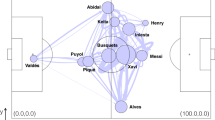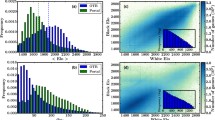Abstract
Soccer is a worldwide sport. Every 4 years since 1930, the sport stimulates a growing number of people, countries, and money during the Soccer World Cup. This scientific treatment of matches using complex networks and social networks focuses on the teams participating in the tournaments, as well as on the interaction between players. The present work aims to broaden the scope of studies focusing on referees’ networks. For this purpose, we built referees’ networks of all World Cup competitions to date. We used indices based on the clique approach for the analyses and characterization of the networks, and the detection of clusters was investigated by identifying communities and islands. Some important results emerge from this study, such as the finding that the networks do not follow a pattern throughout their editions with respect to the indices and the structure. There is, however, a change in procedures from the 2006 World Cup with respect to referee choice. This change leads to the emergence of a pattern in the last four World Cups.









Similar content being viewed by others
References
Andrade JC, Barreto RSFD, Cunha MV, Ribeiro NM, Pereira HBB (2019) Interdisciplinaridade e Teoria de Redes: rede semântica de cliques baseada em ementas e rede de componentes curriculares. iSys Revista Brasileira de Sistemas de Informação 12(3):24–52
Atzmueller M (2017) Descriptive community detection. In: Missaoui R, Kuznetsov S, Obiedkov S (eds) Formal concept analysis of social networks. Lecture notes in social networks. Springer, Berlin, pp 41–58
Azaouzi M, Rhouma D, Ben Romdhane L (2019) Community detection in large-scale social networks: state-of-the-art and future directions. Soc Netw Anal Min 9(1):23. https://doi.org/10.1007/s13278-019-0566-x
Batagelj V, Zaveršnik M (2004) Islands–identifying themes in large networks. In: Sunbelt XXIV Conference, Portoroz
Blondel VD, Guillaume JL, Lambiotte R, Lefebvre E (2008) Fast unfolding of communities in large networks. J Stat Mech Theory Exp 10:P10008. https://doi.org/10.1088/1742-5468/2008/10/P10008
Capocci A, Servedio VD, Caldarelli G, Colaiori F (2005) Detecting communities in large networks. Phys A 352(2–4):669–676. https://doi.org/10.1016/j.physa.2004.12.050
Clauset A, Newman M, Moore A (2004) Finding community structure in very large networks. Phys Rev E 70(6):066111. https://doi.org/10.1103/PhysRevE.70.066111
Clemente FM, Couceiro MS, Martins FML, Mendes RS (2015) Using network metrics in soccer: a macro-analysis. J Hum Kinetic 45(1):123–134. https://doi.org/10.1515/hukin-2015-0013
Conde-Cespedes P, Ngonmang B, Viennet E (2018) An efficient method for mining the maximal α-quasi-clique-community of a given node in complex networks. Soc Netw Anal Min 8(1):20. https://doi.org/10.1007/s13278-018-0497-y
Fadigas IS, Pereira HBB (2013) A network approach based on cliques. Phys A 392(10):2576–2587. https://doi.org/10.1016/j.physa.2013.01.055
Ghalmane Z, Hassouni ME, Cherifi H (2019) Immunization of networks with non-overlapping community structure. Soc Netw Anal Min 9(1):45. https://doi.org/10.1007/s13278-019-0591-9
Girvan M, Newman MEJ (2002) Community structure in social and biological networks. PNAS 99(12):7821–7826. https://doi.org/10.1073/pnas.122653799
Gould P, Gatrell A (1980) A structural analysis of a game: the liverpool v manchester united cup final of 1977. Soc Netw 2(3):253–273. https://doi.org/10.1016/0378-8733(79)90017-0
Grilo M, Fadigas IS, Miranda JGV, Cunha MV, Monteiro RLS, Pereira HBB (2017) Robustness in semantic networks based on cliques. Phys A 472(2017):94–102. https://doi.org/10.1016/j.physa.2016.12.087
Grund TU (2012) Network structure and team performance: the case of English Premier league soccer teams. Soc Netw 34(4):682–690. https://doi.org/10.1016/j.socnet.2012.08.004
Ignatov DI, Semenov A, Komissarova D, Gnatyshak DV (2017) Multimodal clustering for community detection. In: Missaoui R, Kuznetsov S, Obiedkov S (eds) Formal concept analysis of social networks. Lecture notes in social networks. Springer, Berlin, pp 59–96
Kooij R, Jamakovic A, Van Kesteren F, De Koning T, Theisler I, Veldhoven P (2009) The Dutch soccer team as a social network. Connections 29(1):4–14
Onody RN, de Castro PA (2004) Complex network study of Brazilian soccer players. Phys Ver E 70(3):037103. https://doi.org/10.1103/PhysRevE.70.037103
Pereira HBB, Fadigas IS, Senna V, Moret MA (2011) Semantic networks based on titles of scientific papers. Phys A 390(2011):1192–1197. https://doi.org/10.1016/j.physa.2010.12.001
Rosa MG, Fadigas IS, Andrade MTT, Pereira HBB (2014) Clique approach for networks: applications for coauthorship networks. Soc Netw 3(02):80. https://doi.org/10.4236/sn.2014.32010
Sarangi S, Unlu E (2010) Key players and key groups in teams: a network approach using soccer data. DIW Berlin discussion paper no. 1053. https://dx.doi.org/10.2139/ssrn.1679776
Watts DJ, Strogatz SH (1998) Collective dynamics of ‘small-world’ networks. Nature 6684(393):440–442. https://doi.org/10.1038/30918
Author information
Authors and Affiliations
Corresponding author
Additional information
Publisher's Note
Springer Nature remains neutral with regard to jurisdictional claims in published maps and institutional affiliations.
Rights and permissions
About this article
Cite this article
de Sousa Fadigas, I., Grilo, M., Henrique, T. et al. FIFA World Cup referees’ networks: a constant-size clique approach. Soc. Netw. Anal. Min. 10, 54 (2020). https://doi.org/10.1007/s13278-020-00672-5
Received:
Revised:
Accepted:
Published:
DOI: https://doi.org/10.1007/s13278-020-00672-5




